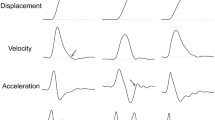Abstract
Rapid targeted movements are subject to special control considerations, since there may be inadequate time available for either visual or somatosensory feedback to be effective. In our experiments, subjects rapidly rotated a knob to align a pointer to one of several targets. We recognized three different types of movement segments: the primary movement, and two types of submovement, which frequently followed. The submovements were initiated either before or after the end of the primary movement. The former, or “overlapping” type of submovement altered the kinematics of the overall movement and was consequently difficult to detect. We used a direct, objective test of movement regularity to detect overlapping submovements, namely, examining the number of jerk and snap zero crossings during the second half of a movement. Any overlapping submovements were parsed from the overall movement by subtracting the velocity profile of the primary movement. The velocity profiles of the extracted submovements had near-symmetric bell shapes, similar to the shapes of both pure primary movements and nonoverlapping submovements. This suggests that the same neural control mechanisms may be responsible for producing all three types of movement segments. Overlapping submovements corrected for errors in the amplitude of the primary movement. Furthermore, they may account for the previously observed, speed-dependent asymmetry of the velocity profile. We used a nonlinear model of the musculoskeletal system to explain most of the kinematic features of these rapid hand movements, including how discrete submovements are superimposed on a primary movement. Finally, we present a plausible scheme for how the central nervous system may generate the commands to control these rapid hand movements.
Similar content being viewed by others
Author information
Authors and Affiliations
Corresponding author
Rights and permissions
About this article
Cite this article
Novak, K.E., Miller, L.E. & Houk, J.C. The use of overlapping submovements in the control of rapid hand movements. Exp Brain Res 144, 351–364 (2002). https://doi.org/10.1007/s00221-002-1060-6
Received:
Accepted:
Published:
Issue Date:
DOI: https://doi.org/10.1007/s00221-002-1060-6




